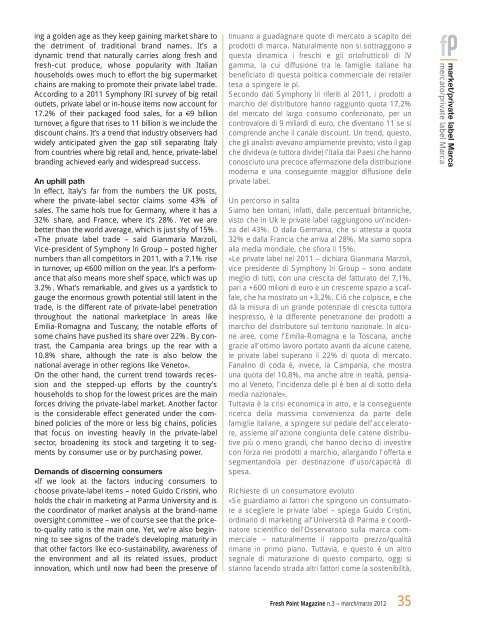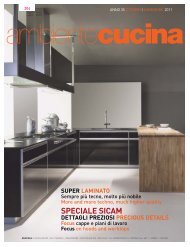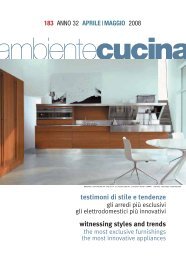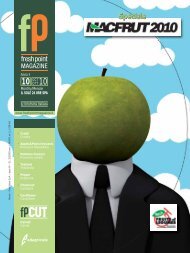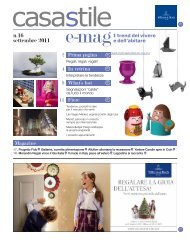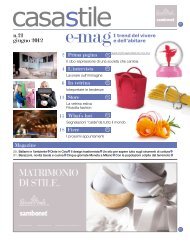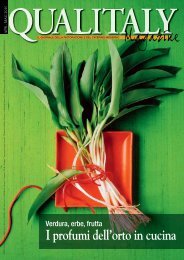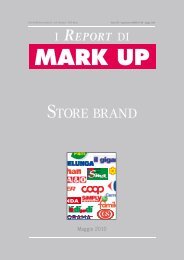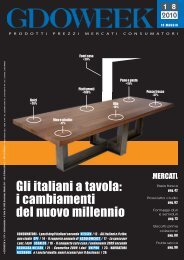Fresh Point Magazine - B2B24 - Il Sole 24 Ore
Fresh Point Magazine - B2B24 - Il Sole 24 Ore
Fresh Point Magazine - B2B24 - Il Sole 24 Ore
You also want an ePaper? Increase the reach of your titles
YUMPU automatically turns print PDFs into web optimized ePapers that Google loves.
ing a golden age as they keep gaining market share to<br />
the detriment of traditional brand names. It’s a<br />
dynamic trend that naturally carries along fresh and<br />
fresh-cut produce, whose popularity with Italian<br />
households owes much to effort the big supermarket<br />
chains are making to promote their private label trade.<br />
According to a 2011 Symphony IRI survey of big retail<br />
outlets, private label or in-house items now account for<br />
17.2% of their packaged food sales, for a €9 billion<br />
turnover, a figure that rises to 11 billion is we include the<br />
discount chains. It’s a trend that industry observers had<br />
widely anticipated given the gap still separating Italy<br />
from countries where big retail and, hence, private-label<br />
branding achieved early and widespread success.<br />
An uphill path<br />
In effect, Italy’s far from the numbers the UK posts,<br />
where the private-label sector claims some 43% of<br />
sales. The same hols true for Germany, where it has a<br />
32% share, and France, where it’s 28%. Yet we are<br />
better than the world average, which is just shy of 15%.<br />
«The private label trade – said Gianmaria Marzoli,<br />
Vice-president of Symphony Iri Group – posted higher<br />
numbers than all competitors in 2011, with a 7.1% rise<br />
in turnover, up €600 million on the year. It’s a performance<br />
that also means more shelf space, which was up<br />
3.2%. What’s remarkable, and gives us a yardstick to<br />
gauge the enormous growth potential still latent in the<br />
trade, is the different rate of private-label penetration<br />
throughout the national marketplace In areas like<br />
Emilia-Romagna and Tuscany, the notable efforts of<br />
some chains have pushed its share over 22%. By contrast,<br />
the Campania area brings up the rear with a<br />
10.8% share, although the rate is also below the<br />
national average in other regions like Veneto».<br />
On the other hand, the current trend towards recession<br />
and the stepped-up efforts by the country’s<br />
households to shop for the lowest prices are the main<br />
forces driving the private-label market. Another factor<br />
is the considerable effect generated under the combined<br />
policies of the more or less big chains, policies<br />
that focus on investing heavily in the private-label<br />
sector, broadening its stock and targeting it to segments<br />
by consumer use or by purchasing power.<br />
Demands of discerning consumers<br />
«If we look at the factors inducing consumers to<br />
choose private-label items – noted Guido Cristini, who<br />
holds the chair in marketing at Parma University and is<br />
the coordinator of market analysis at the brand-name<br />
oversight committee – we of course see that the priceto-quality<br />
ratio is the main one. Yet, we’re also beginning<br />
to see signs of the trade’s developing maturity in<br />
that other factors like eco-sustainability, awareness of<br />
the environment and all its related issues, product<br />
innovation, which until now had been the preserve of<br />
tinuano a guadagnare quote di mercato a scapito dei<br />
prodotti di marca. Naturalmente non si sottraggono a<br />
questa dinamica i freschi e gli ortofrutticoli di IV<br />
gamma, la cui diffusione tra le famiglie italiane ha<br />
beneficiato di questa politica commerciale dei retailer<br />
tesa a spingere le pl.<br />
Secondo dati Symphony Iri riferiti al 2011, i prodotti a<br />
marchio del distributore hanno raggiunto quota 17,2%<br />
del mercato del largo consumo confezionato, per un<br />
controvalore di 9 miliardi di euro, che diventano 11 se si<br />
comprende anche il canale discount. Un trend, questo,<br />
che gli analisti avevano ampiamente previsto, visto il gap<br />
che divideva (e tuttora divide) l’Italia dai Paesi che hanno<br />
conosciuto una precoce affermazione della distribuzione<br />
moderna e una conseguente maggior diffusione delle<br />
private label.<br />
Un percorso in salita<br />
Siamo ben lontani, infatti, dalle percentuali britanniche,<br />
visto che in Uk le private label raggiungono un’incidenza<br />
del 43%. O dalla Germania, che si attesta a quota<br />
32% e dalla Francia che arriva al 28%. Ma siamo sopra<br />
alla media mondiale, che sfiora il 15%.<br />
«Le private label nel 2011 – dichiara Gianmaria Marzoli,<br />
vice presidente di Symphony Iri Group – sono andate<br />
meglio di tutti, con una crescita del fatturato del 7,1%,<br />
pari a +600 milioni di euro e un crescente spazio a scaffale,<br />
che ha mostrato un +3,2%. Ciò che colpisce, e che<br />
dà la misura di un grande potenziale di crescita tuttora<br />
inespresso, è la differente penetrazione dei prodotti a<br />
marchio del distributore sul territorio nazionale. In alcune<br />
aree, come l’Emilia-Romagna e la Toscana, anche<br />
grazie all’ottimo lavoro portato avanti da alcune catene,<br />
le private label superano il 22% di quota di mercato.<br />
Fanalino di coda è, invece, la Campania, che mostra<br />
una quota del 10,8%, ma anche altre in realtà, pensiamo<br />
al Veneto, l’incidenza delle pl è ben al di sotto della<br />
media nazionale».<br />
Tuttavia è la crisi economica in atto, e la conseguente<br />
ricerca della massima convenienza da parte delle<br />
famiglie italiane, a spingere sul pedale dell’acceleratore,<br />
assieme all’azione congiunta delle catene distributive<br />
più o meno grandi, che hanno deciso di investire<br />
con forza nei prodotti a marchio, allargando l’offerta e<br />
segmentandola per destinazione d’uso/capacità di<br />
spesa.<br />
Richieste di un consumatore evoluto<br />
«Se guardiamo ai fattori che spingono un consumatore<br />
a scegliere le private label – spiega Guido Cristini,<br />
ordinario di marketing all’Università di Parma e coordinatore<br />
scientifico dell’Osservatorio sulla marca commerciale<br />
– naturalmente il rapporto prezzo/qualità<br />
rimane in primo piano. Tuttavia, e questo è un altro<br />
segnale di maturazione di questo comparto, oggi si<br />
stanno facendo strada altri fattori come la sostenibilità,<br />
<strong>Fresh</strong> <strong>Point</strong> <strong>Magazine</strong> n.3 – march/marzo 2012<br />
35<br />
market/private label Marca<br />
mercato/private label Marca


